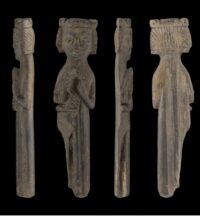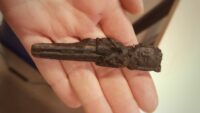 A small statuette of a crowned figure with a peregrine falcon has been found in an excavation of the historic downtown of Oslo. The design of the hair and clothing dates the figurine to the 13th century, which makes it one of the earliest representations of falconry in Scandinavia, and one of only a handful of falconry-related art from the period found in all of Northern Europe.
A small statuette of a crowned figure with a peregrine falcon has been found in an excavation of the historic downtown of Oslo. The design of the hair and clothing dates the figurine to the 13th century, which makes it one of the earliest representations of falconry in Scandinavia, and one of only a handful of falconry-related art from the period found in all of Northern Europe.
Archaeologists from the Norwegian Institute for Cultural Heritage Research (NIKU) have been surveying the Middelalderparken (Medieval Park) site in Oslo’s Old Town since August, unearthing remains of the city’s medieval streets, buildings and infrastructure. Their heroic efforts continued into the Norwegian winter,
The figure is 7.5 cm (3″) high and made of either bone or antler. It is a long, flattish oval carved on both sides. The figure has a peaceful smile and neck-length hair. Its not clear if the individual is male or female, as the braided hair and long robe could have been worn by either a king or a queen. The crown is short and crenellated with holes in the center of the high sections.
The falcon is perched on the monarch’s right arm which is protected by a hawking glove. The bird’s feathers are carved in a grid pattern. Both human and bird have drilled holes for eyes. There is also a hole through the bottom of the figure, indicating that it may have been the haft of a knife.
 It was discovered in a waste layer a stone’s throw from the Kongsgården, the royal estate in Oslo, which in the mid-13th century was expanded into a fortified castle by Haakon IV Haakonsson (r. 1217-1263). Haakon IV was literate and cultured. He consolidated the power of the Norwegian monarchy after years of civil wars and sought to pattern Norway’s court along European lines. Literate and well-educated from a young age, he commissioned the first Norse translations of the chansons de geste. His royal estates were modeled after the monumental palaces of Europe and his foreign policy was focused on building friendly trade relations with the rulers of neighboring countries in northern Europe, Haneatic towns and the Mediterranean.
It was discovered in a waste layer a stone’s throw from the Kongsgården, the royal estate in Oslo, which in the mid-13th century was expanded into a fortified castle by Haakon IV Haakonsson (r. 1217-1263). Haakon IV was literate and cultured. He consolidated the power of the Norwegian monarchy after years of civil wars and sought to pattern Norway’s court along European lines. Literate and well-educated from a young age, he commissioned the first Norse translations of the chansons de geste. His royal estates were modeled after the monumental palaces of Europe and his foreign policy was focused on building friendly trade relations with the rulers of neighboring countries in northern Europe, Haneatic towns and the Mediterranean.
As part of alliance building, he gifted falcons far beyond the European continent. Alliances were entered into and maintained through marriages and gifts. The most precious gift a Norwegian king could give was a falcon.
Since falconry was a common royal and noble practice throughout the Middle Ages, we cannot say for certain that the figure portrays King Håkon. However, dating and context indicates that it is a strong possibility.